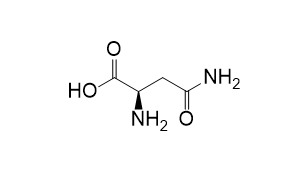D-Asparagine
D-asparagine has antioxidant activity.D-asparagine can reduce shoot growth inhibition under NaCl stress in shoot growth of rice seedlings, but it could further enhance NaCl inhibition of root growth.
Inquire / Order:
manager@chemfaces.com
Technical Inquiries:
service@chemfaces.com
Tel:
+86-27-84237783
Fax:
+86-27-84254680
Address:
1 Building, No. 83, CheCheng Rd., Wuhan Economic and Technological Development Zone, Wuhan, Hubei 430056, PRC
Providing storage is as stated on the product vial and the vial is kept tightly sealed, the product can be stored for up to
24 months(2-8C).
Wherever possible, you should prepare and use solutions on the same day. However, if you need to make up stock solutions in advance, we recommend that you store the solution as aliquots in tightly sealed vials at -20C. Generally, these will be useable for up to two weeks. Before use, and prior to opening the vial we recommend that you allow your product to equilibrate to room temperature for at least 1 hour.
Need more advice on solubility, usage and handling? Please email to: service@chemfaces.com
The packaging of the product may have turned upside down during transportation, resulting in the natural compounds adhering to the neck or cap of the vial. take the vial out of its packaging and gently shake to let the compounds fall to the bottom of the vial. for liquid products, centrifuge at 200-500 RPM to gather the liquid at the bottom of the vial. try to avoid loss or contamination during handling.
TCI CO.2019, US20190151257A1
Food Research International2020, 108987
Plant Physiol.2023, 193(3):1758-1771.
Eur J Pharmacol.2022, 917:174744.
J Ethnopharmacol.2021, 267:113615.
Chem Biol Interact.2024, 403:111249.
Antioxidants (Basel).2023, 12(7):1324.
Srinagarind Medical Journal2019, 34(1)
Asian J of Pharmaceutical&Clinical 2018, 11(2)
Molecules.2024, 29(5):1048.
Related and Featured Products
Biologia Plantarum, 1995, 37(2):305-308.
NaCl stress in rice seedlings: effects of L-proline, glycinebetaine, L-and D-asparagine on seedling growth.[Reference:
WebLink]
METHODS AND RESULTS:
The effect of L-proline, glycinebetaine, L- asparagine and D-Asparagine on rice seedling growth under NaCl stress was investigated.
CONCLUSIONS:
Glycinebetaine and L-asparagine were not effective in reducing NaCl inhibition in shoot growth of rice seedlings. L-Proline and D-Asparagine were found to be able to reduce shoot growth inhibition under NaCl stress. However, L-proline, glycinebetaine, D-Asparagine and L-asparagine further enhanced NaCl inhibition of root growth.
Journal of Food ence & Nutrition, 2008, 13(3):182-189.
The Effect of pH on the Antioxidative Activity of Melanoidins Formed from Glucose and Fructose with L and D-Asparagine in the Maillard Reaction.[Reference:
WebLink]
METHODS AND RESULTS:
In this study, the effect of pH on the antioxidative activities of melanoidins formed as a result of the reaction between sugars, glucose (Glc) or fructose (Fru), and amino acids, L-asparagine (L-Asn) and D-Asparagine (D-Asn) are examined. For this purpose, antioxidative activities were evaluated on the basis of reducing power, including ferric reducing/antioxidant power (FRAP) and free radical scavenging activity includes 1,1-diphenyl-2-picryl- hydrazil (DPPH) and 2,2'-azinobis(3-ethylbenothiazoline-6-sulfonic acid) diammonium salt (ABTS) and ferrous ion chelating activity. Ethylene diamine tetraacetate (EDTA) and trolox, a water-soluble analog of tocopherol, were used as reference antioxidant compounds. The antioxidative activities of the melanoidins at a pH of 7.0 were greater than those with a pHs of 4.0 and pH 10.0.
CONCLUSIONS:
Especially, it was found that the melanoidins formed from D-isomers are more effective antioxidants in different in vitro assays. The reducing power and chelating activity of the melanoidins formed from the Fru systems were higher than those of the melanoidins formed from the Glc systems. However, the ABTS radical scavenging activity of the melanoidins formed from the Glc systems were higher than those of the melanoidins formed from the Fru systems. In particular, the DPPH radical scavenging activity and the FRAP of the melanoidins showed different antioxidative activities according to pH level.



